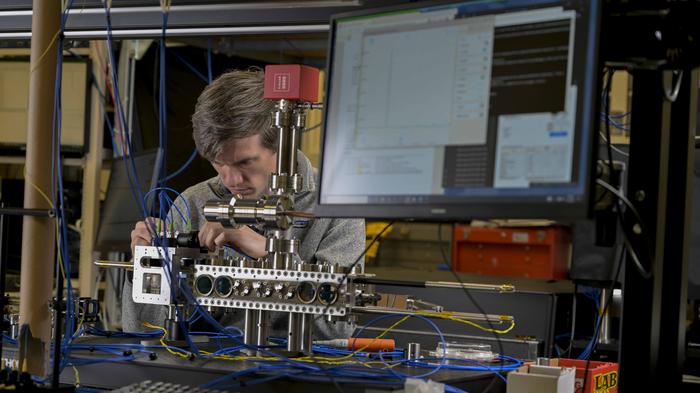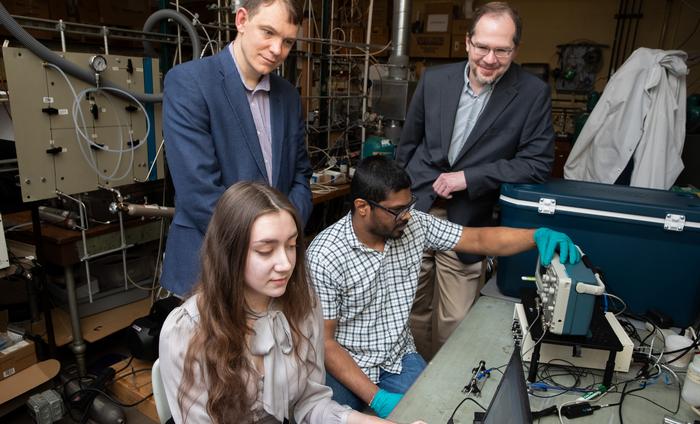Shaking Disrupts Stem Cell Clocks via TEAD Pathway
In a groundbreaking study poised to redefine our understanding of stem cell biology and circadian regulation, researchers have unveiled how mechanical stimulation significantly alters the intrinsic rhythmicity of induced pluripotent stem cells (iPSCs) as they differentiate into osteogenic lineages. This discovery not only deepens the scientific grasp of temporal dynamics in cellular differentiation but also […]


In a groundbreaking study poised to redefine our understanding of stem cell biology and circadian regulation, researchers have unveiled how mechanical stimulation significantly alters the intrinsic rhythmicity of induced pluripotent stem cells (iPSCs) as they differentiate into osteogenic lineages. This discovery not only deepens the scientific grasp of temporal dynamics in cellular differentiation but also opens promising avenues for regenerative medicine and tissue engineering, where precision timing may be a critical yet underappreciated factor.
The team, led by Fu, Okawa, and Vinaikosol, focused on the effects of shaking culture, a prevalent mechanical stimulation technique, on the circadian clock machinery inherent in iPSCs undergoing osteogenic differentiation. Circadian rhythms, the approximately 24-hour cycles governing physiological processes, have previously been shown to influence cellular functions ranging from metabolism to cell division. However, their role and modulation during stem cell fate determination have remained enigmatic and underexplored.
Central to the study is the TEAD-Fbxl3-CRY axis, a molecular cascade that integrates mechanical cues with circadian regulation. TEAD transcription factors, known for their pivotal role in controlling gene expression linked to cell proliferation and differentiation, appear to orchestrate the downstream activity of Fbxl3, an F-box protein that targets circadian repressors such as CRY for ubiquitination and proteasomal degradation. This axis acts as an essential intermediary transforming mechanical forces from the shaking culture environment into tangible alterations in the molecular circadian clock.
Experimental evidence from carefully controlled shaking culture systems demonstrated a marked attenuation of circadian amplitude in iPSCs progressing toward osteoblast-like phenotypes. This attenuation manifests as dampened oscillations in core clock genes, particularly cryptochromes (CRYs), which are fundamental repressors within the circadian feedback loop. The dampened rhythms suggest that continuous mechanical stimulation disrupts the normal temporal signaling required for finely tuned gene expression during differentiation.
The importance of this finding lies in the intricate interplay between circadian biology and stem cell fate decisions. Osteogenic differentiation is a tightly regulated process involving sequential activation and repression of lineage-specific genes. Disruption of circadian rhythms may lead to aberrant timing in gene expression, potentially influencing the functionality and quality of differentiated bone cells. This concept challenges existing paradigms that often overlook temporal regulation in the differentiation milieu.
Moreover, the identification of the TEAD-Fbxl3-CRY axis as a key mediator provides a molecular handle to manipulate circadian dynamics experimentally. By modulating TEAD activity or Fbxl3 expression, it may be possible to rescue or fine-tune circadian oscillations even under mechanical stress. Such interventions could enhance the robustness and predictability of stem cell-derived osteogenic therapies, which are essential for skeletal repair and regeneration.
Mechanotransduction, the process through which cells convert mechanical stimuli into biochemical signals, has been increasingly recognized as a critical regulator in stem cell biology. Shaking culture represents a form of dynamic mechanical stimulation that mimics physiological movements inherent to bone tissue. Insights from this study suggest that mechanotransduction not only influences cytoskeletal organization and gene expression but extends its regulatory reach to the cellular timekeeping mechanisms.
Interestingly, this attenuation of circadian rhythms under shaking conditions contrasts with previous observations in static cultures, highlighting the complexity of in vitro differentiation systems. These findings underscore the necessity to consider culture conditions as active variables that profoundly affect cellular phenotypes and molecular states. It also raises questions about how in vivo mechanical forces influence circadian biology during bone development and remodeling.
The researchers employed sophisticated techniques such as real-time bioluminescence reporting of circadian gene activity, quantitative PCR, and protein interaction assays to delineate the molecular underpinnings of this phenomenon. The convergence of these methodologies enabled a comprehensive characterization of the TEAD-Fbxl3-CRY pathway’s involvement and established a direct causative link between mechanical cues and circadian modulation.
Looking ahead, this work paves the way for designing biomimetic culture systems that could harness or circumvent mechanical influences on circadian regulation, tailoring differentiation protocols with temporal precision. Such approaches could optimize the generation of bone tissue constructs with enhanced functionality and integration potential upon transplantation.
Beyond osteogenesis, the broader implications of this research hint at an overarching principle wherein mechanical environments serve as temporal “zeitgebers” (time-givers), synchronizing or disrupting circadian clocks across diverse stem cell types and tissues. Future studies may explore whether similar mechanisms operate in other lineage pathways and how these dynamics affect aging, disease susceptibility, and tissue homeostasis.
This revelation of shaking culture’s influence on circadian rhythms also resonates with an evolving appreciation of chronobiology in regenerative medicine. By aligning cell therapy strategies with circadian principles, clinicians and researchers may improve therapeutic efficacy, minimize adverse effects, and promote long-term tissue health.
In conclusion, the identification of the TEAD-Fbxl3-CRY axis as a bridge between mechanical stimuli and circadian attenuation in iPSC-derived osteogenic cells represents a significant advance in stem cell biology. It challenges us to rethink the temporal dimension within differentiation paradigms, emphasizing that the “when” can be just as critical as the “what” and “how” in guiding cell fate and function. As this line of research progresses, it promises to unlock new strategies for better harnessing the potential of stem cells in medicine, engineering, and understanding fundamental biological rhythms.
Subject of Research:
Article Title:
Article References: Fu, Y., Okawa, H., Vinaikosol, N. et al. Shaking culture attenuates circadian rhythms in induced pluripotent stem cells during osteogenic differentiation through the TEAD-Fbxl3-CRY axis. Cell Death Discov. 11, 252 (2025). https://doi.org/10.1038/s41420-025-02533-6
Image Credits: AI Generated
DOI: https://doi.org/10.1038/s41420-025-02533-6
Tags: circadian regulation in stem cellscircadian rhythms and metabolismFbxl3 and CRY axis in cell biologyinduced pluripotent stem cells differentiationmechanical stimulation of stem cellsmolecular mechanisms of stem cell fateosteogenic lineage differentiationregenerative medicine applicationsstem cell biologyTEAD pathway in stem cellstemporal dynamics in cellular differentiationtissue engineering innovations
What's Your Reaction?

































